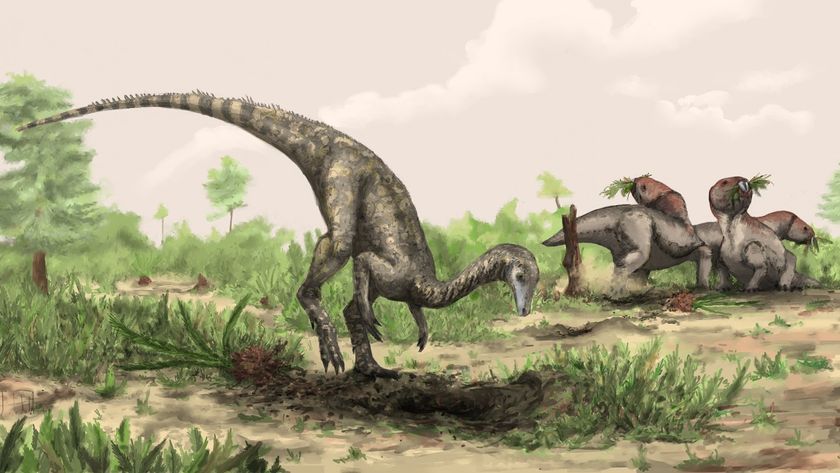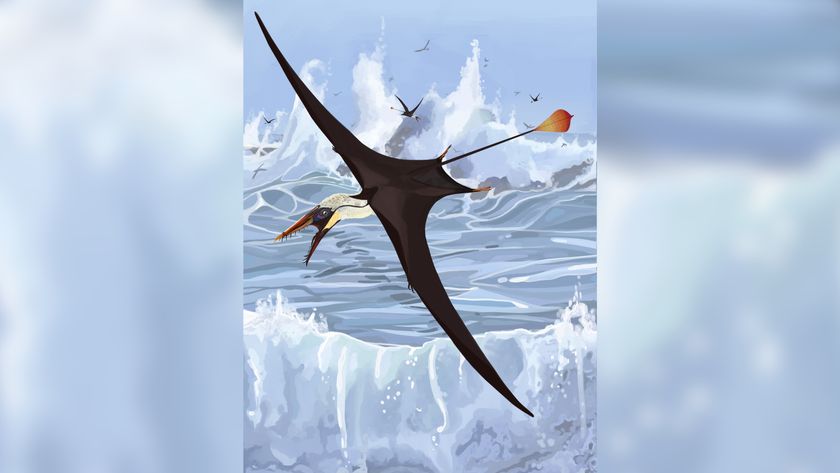Triceratops: Facts about the three-horned dinosaur
Triceratops lived at the end of the Cretaceous period, between 67 million and 65 million years ago. Once considered solitary, new fossil discoveries indicate it was a social animal that may have lived in herds.
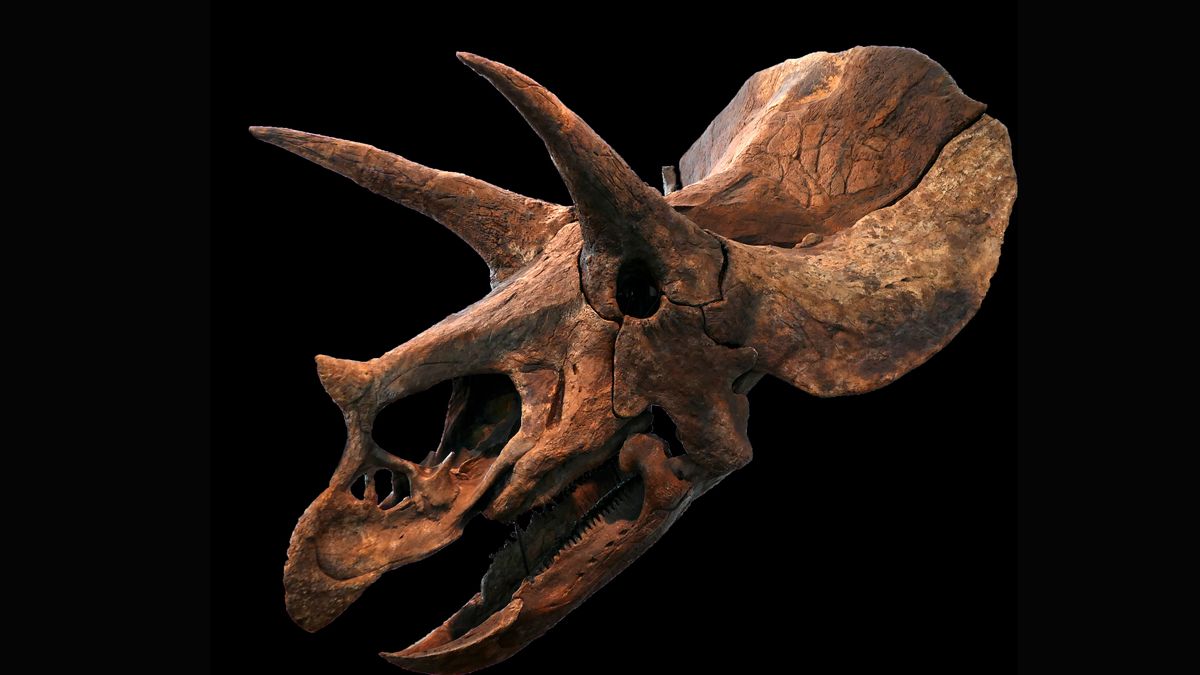
Triceratops, with its three horns and bony frill around the back of its head, is one of the most recognizable dinosaurs. Its name is a combination of the Greek syllables tri-, meaning "three," kéras, meaning "horn," and ops, meaning "face." The dinosaur roamed North America about 67 million to 65 million years ago, during the end of the Cretaceous Period (145 million to 66 million years ago).
How many Triceratops species were there?
Since Triceratops' discovery in 1887, up to 16 species of the dinosaur have been proposed, but only two species — T. horridus and T. prorsus — are currently considered valid, according to a 2014 study in the journal PNAS, which found that T. horridus likely evolved into T. prorsus over a span of 1 million to 2 million years.
For the study, researchers collected and analyzed dinosaur fossils from the Hell Creek Formation in Montana, which contains lower, middle and upper geological subdivisions. The most commonly recovered dinosaur from the formation was Triceratops, said study first author John Scannella, a paleontologist and Triceratops expert at Montana State University.
"We started to notice that the Triceratops in the lower unit of the formation are different from those in the upper unit," Scannella told Live Science. "And Triceratops in the middle unit have a combination of features seen in individuals found in the lower and upper units."
Triceratops prorsus, he said, is found in the upper unit of the formation, and specimens in the upper portion of the middle unit have more T. prorsus features and fewer T. horridus features.
There is currently some debate about whether two other genera of Ceratopsidae (the taxonomic family Triceratops belongs to), Torosaurus and Nedoceratops (formerly Diceratops), are really distinct genera or just Triceratops specimens at different life stages.
In a 2010 study in the Journal of Vertebrate Paleontology, Scannella and his colleague John ("Jack") Horner argued that Torosaurus, which is mainly distinguished from Triceratops by having an expanded frill with large holes, was actually Triceratops in old age. "We found evidence that the frill on the back of the skull [of Triceratops] expands relatively late during growth," Scannella said, adding that the microscructure of Torosaurus bones suggests they are older than even the largest Triceratops specimens. "This suggested that Torosaurus, rather than being a distinct genus, was actually a fully grown Triceratops."
Related: Tyrannosaurus rex: Facts and photos of the dinosaur king
In a subsequent 2011 study in the journal PLOS ONE, Scannella and Horner used similar reasoning to argue Nedoceratops hatcheri, of which there is only a single specimen, is actually a transitional stage between the young Triceratops and the old Torosaurus. Again, one of the main differences between the animals in question is the frill: Torosaurus has large frill holes, which are smaller in Nedoceratops and absent in Triceratops (though some specimens appear to show evidence of the beginning of holes). This suggests that the holes grow over time as the frill develops and expands, they reasoned.
However, some other paleontologists contest this single-genus idea. In a 2012 PLOS ONE article, for instance, researchers presented evidence of Torosaurus bones that are not fully fused, suggesting the specimen is still immature (and, therefore, not a fully mature Triceratops). They further suggested the frill holes of Nedoceratops are pathological (related to a disease or health issue).
More fossils of Nedoceratops and a distinctly juvenile specimen of Torosaurus would settle the debate, Scannella said.
An elephant-size dinosaur
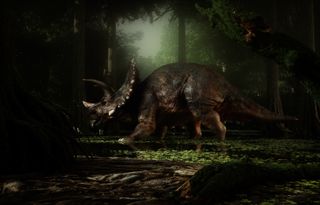
Triceratops was a massive animal, comparable in size to an African elephant, according to a 2011 article in the journal Cretaceous Research. It grew up to 30 feet (9 meters) and weighed well over 11,000 lbs. (5,000 kg) — some large specimens weighed nearly 15,750 lbs. (7,150 kg).
It had strong limbs to move and support its massive body. The forelimbs, which were shorter than the rear ones, each had three hooves; the rear limbs had four hooves each. A 2012 study in the journal Proceedings of the Royal Society B suggested that Triceratops had an upright posture like an elephant's, rather than a sprawling, elbows-out posture like a lizard's.
The head of Triceratops was among the largest of all land animals, some making up one-third of the entire length of the dinosaur's body. The largest skull found has an estimated length of 8.2 feet (2.5 meters), according to Scannella's 2010 Journal of Vertebrate Paleontology study.
Triceratops had three horns: two massive ones above its eyes, and a smaller horn on its snout. The two brow horns appear to have twisted and lengthened as a Triceratops aged, according to a 2006 study in the journal Proceedings of the Royal Society B. During a Triceratops' juvenile years, its horns were little stubs that curved backward; as the animal continued to grow into young adulthood, the horns straightened out; finally, the horns curved forward and grew up to 3 feet long (1 meter), probably after the dinosaur reached sexual maturity.
It is likely Triceratops' horns and frill were used in combat against other Triceratops, as well as for visual display (mating, communication and species recognition), according to a 2009 PLOS ONE study.
The dinosaur also used its horns and frill in fights against its main predator, tyrannosaurs. Paleontologists have uncovered brow horn and skull Triceratops bones that were partially healed from tyrannosaur tooth marks, suggesting the Triceratops successfully fended off its attacker, according to a study published in the book "Tyrannosaurus rex, the Tyrant King" (2008, Indiana University Press). But T. rex bite marks on other Triceratops bones suggests the carnivore did sometimes feed on the horned dinosaur, a 1996 Journal of Vertebrate Paleontology study suggests.
Instead of being smooth, the skin of Triceratops, at least around its tail, may have been covered in bristle-like formations, similar to the ancient ceratopsian Psittacosaurus.
What did Triceratops eat?
Triceratops was an herbivore, existing mostly on shrubs and other plant life. Its beak-like mouth was best suited for grasping and plucking rather than biting, according to a 1996 analysis in the journal Evolution. It also likely used its horns and bulk to tip over taller plants.
It had up to 800 teeth that were constantly being replenished, and were arranged in groups called batteries, with each battery having 36 to 40 tooth columns in each side of each jaw and three to five teeth per column, the Evolution study notes. It may have eaten a range of plants, including ferns, cycads and palms.
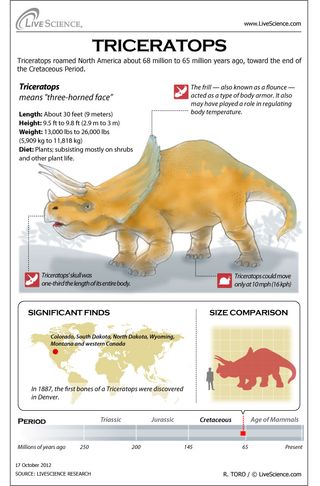
Fossil discoveries
In 1887, the first bones of a Triceratops were discovered in Denver and were sent to Othniel Charles Marsh. At first, Marsh believed it was a bison. It wasn't until more Triceratops bones were found in 1888 that Marsh gave the beast the name Triceratops.
To date, more than 50 Triceratops skulls have been found in the Hell Creek Formation alone, according to Scannella's 2014 PNAS study.
While no complete skeleton has been unearthed, partial skeletons and skulls, including some from babies, have been found in Montana, South Dakota, North Dakota, Colorado, Wyoming and Canada (Saskatchewan and Alberta). Triceratops was confined to North America because the continent had already split from Europe and, along with South America, had begun to drift across the ocean by the time the dinosaur evolved. [Tiny & Old: Images of Triceratops Ancestors]
Was Triceratops a social animal?
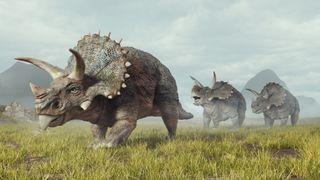
Triceratops fossils have typically been discovered as solitary individuals. But in a 2009 article in the Journal of Vertebrate Paleontology, scientists reported the first discovery of a Triceratops "bonebed," which contained three juvenile remains together and suggested a gregarious (and possibly herding) nature to the dinosaurs.
In 2013, researchers searching for Tyrannosaurus in Wyoming stumbled on something unexpected — a group of triceratops that had lived and died together. After a decade of excavations, they had uncovered over 1,200 bones belonging to at least five individuals.
The bonebed indicates the individuals died together, as a group, potentially in a swamp. Analysis of the teeth found at the site indicates they were migratory, and traveled together across long distances. "And that of course leads to all kinds of new questions," Jimmy de Rooij, a paleontologist at Utrecht University in the Netherlands who was part of the excavation team, said in a statement. "How complex was this social behavior, exactly?"
Kim Ann Zimmermann contributed to this article.
This article was updated 04/05/2024 at 11 a.m. ET.
Sign up for the Live Science daily newsletter now
Get the world’s most fascinating discoveries delivered straight to your inbox.

